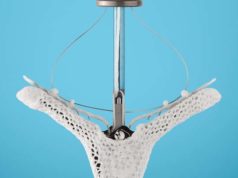
The MitraClip device (Abbott) continues to demonstrate safety and efficacy at three years in patients with heart failure and secondary mitral regurgitation (MR), findings from the COAPT trial have shown. In addition, patients who crossed over and received the MitraClip after 24 months showed the same benefits as those who received the device at the beginning of the study. And, an economic analysis of COAPT data has found it provides “intermediate to high economic value”.
Safety and efficacy data were announced at a late-breaking session at the Transcatheter Cardiovascular Therapeutics scientific symposium (TCT 2019; 25–29 September, San Francisco, USA) by Michael J Mack (Baylor Scott & White Health, Dallas, USA). Findings from the cost-effectiveness analysis were also presented at TCT 2019, and published in Circulation, by Suzanne J Baron (Lahey Hospital and Medical Center, Burlington, and Saint Luke‘s Mid America Heart Institute, Kansas City, USA).
COAPT was a randomised, parallel-controlled, open-label multicentre trial evaluating transcatheter mitral valve repair with the MitraClip device in patients with heart failure and moderate-to-severe or severe secondary MR who remained symptomatic despite maximally-tolerated guideline directed medical therapy. Between December 2012 and June 2017, 614 subjects were enrolled and randomised at 78 centres in the USA and Canada—312 to MitraClip plus medical therapy, and 302 to medical therapy only.
At two years, COAPT found that treatment with MitraClip improved survival, reduced heart failure hospitalisations, and improved quality of life compared to maximally-tolerated guideline-directed medical therapy alone. Per protocol, subjects randomised to medical therapy were not allowed to crossover to the MitraClip prior to 24 months, but were permitted to do so after 24 months.
Mack explained: “The present study sought to describe the three-year outcomes of patients enrolled in the COAPT trial, including those who crossed over to MitraClip. All the analyses are done on an intention-to-treat basis. And, also to analyse the impact of MitraClip crossovers in patients originally assigned to medical therapy alone.”
The primary effectiveness endpoint was all hospitalisations for heart failure. At 36 months, it was 220 for the MitraClip plus medical therapy arm, compared to 378 in the medical therapy-alone arm (hazard ratio [HR] 0.49, 95% confidence interval [CI] 0.37–0.63, p=0.00000006): “The two year results were highly statistically significant in favour of MitraClip; the number needed to treat was 3.2. If we look at the three-year results, the difference is even more pronounced. The number needed to treat has now gone down to 3.0.”
The primary safety endpoint was freedom from device-related complications; at 36 months, this was 8.7% (1.4% related to the device, and 7.4% related to progressive heart failure). On time to first heart failure hospitalisation, Mack said: “On an intent-to-treat basis, the curves are even more pronounced between two and three years, with the number-needed to treat now being 2.9.”
All-cause mortality for all patients, including crossovers, at three years was 42.8% for MitraClip plus medical therapy versus 55.5% for medical therapy alone (HR 0.67, 95% CI 0.52–0.85, p=0.001), providing, he pointed out, “a sustained mortality benefit that persists out to three years”.
“If we look at the composite of all-cause mortality or heart failure hospitalisation, which is the primary endpoint of the MITRA-FR trial, we see [between two and three years] … a 52% reduction; the number needed to treat to prevent death or heart failure hospitalisation is now 3.4 in favour of the MitraClip.”
And, quality of life as measured by the KCCQ summary score also showed a “persistent benefit in favour of MitraClip patients”, said Mack.
An analysis of those patients who crossed over to MitraClip after two years found similar outcomes as for those treated with MitraClip from the outset: “If we take the patients that crossed over and landmark them back to zero at the time that they crossed over, we have results out to 12 months. The first heart failure hospitalisation was 13.8%, comparable to the patients that were originally assigned to MitraClip therapy. Multivariable predictors of the first heart failure hospitalisation within 36 months [in the medical therapy only group, with crossover as a time adjusted covariate] showed that MitraClip therapy was significantly protective [HR 0.42, 95% CI 0.22–0.8, p=0.009],” said Mack.
There were also comparable outcomes for the composite of all-cause mortality and heart failure hospitalisation for patients that crossed over and those originally assigned to MitraClip therapy.
However, there was no difference found in all-cause mortality. Mack pointed out: “We only saw the mortality benefit of MitraClip starting at 12 months afterwards so it is not surprising that we don’t see a mortality benefit yet.”
Mack summed up: “In patients with moderate to severe secondary mitral regurgitation who remain symptomatic despite medical therapy, at 36 months, MitraClip was safe, provided durable reduction in mitral regurgitation, reduced the rate of heart failure hospitalisations, and improved survival, quality of life and functional capacity compared to medical therapy alone.”
He added: “In patients who were assigned and who crossed-over and received a MitraClip, they experienced fewer heart failure hospitalisations and deaths, or heart failure hospitalisations within 12 months after they crossed over than those who did not crossover, and had rates comparable to patients who were originally assigned to MitraClip.”
In a roundtable discussion that followed the presentation, Mack predicted: “The safety profile and the demonstration of benefit has been good enough that now MitraClip will become the control for future studies of both repair and replacement in heart failure patients for secondary MR. MitraClip has gone from being the test arm to now being the control arm in future trials.”
The COAPT economic analysis found that two-year follow-up costs were approximately US$11,000 per patient lower with MitraClip plus medical therapy compared to medical therapy alone. Unsurprisingly, the upfront cost of the index procedure meant that cumulative two-year costs remained substantially higher following transcatheter mitral valve repair with the MitraClip device ($73,416 vs. $38,345, p<0.001). However, when in-trial survival, health utilities, and costs were modelled over a lifetime horizon, TMVr was projected to increase quality-adjusted life-years (QALYs) by 0.82 years. The results remained consistent across a variety of sensitivity and subgroup analyses.
Baron told the conference: “Over a lifetime horizon, transcatheter mitral valve repair is both more effective, but also more expensive than medical therapy. We estimated that transcatheter mitral valve repair would be associated with an increase of lifetime costs of $45,648, with a resulting incremental cost-effectiveness ratio of $55,600 per QALY [quality adjusted life year] gained.” Comparison with US thresholds of high and low economic value suggest, she said, that “TMVr increases quality adjusted life expectancy compared with medical therapy at an incremental cost per QALY gained that is consistent with intermediate to high economic value”. And she added, subgroup analyses indicated that “TMVr appeared to be particularly cost-effective in those patients under the age of 75, and those with ejection fractions less than 30% at baseline. Future studies are needed to examine the durability of TMVr benefit in this population and to evaluate the cost-effectiveness of TMVr compared with other available and emerging mitral valve therapies.”












